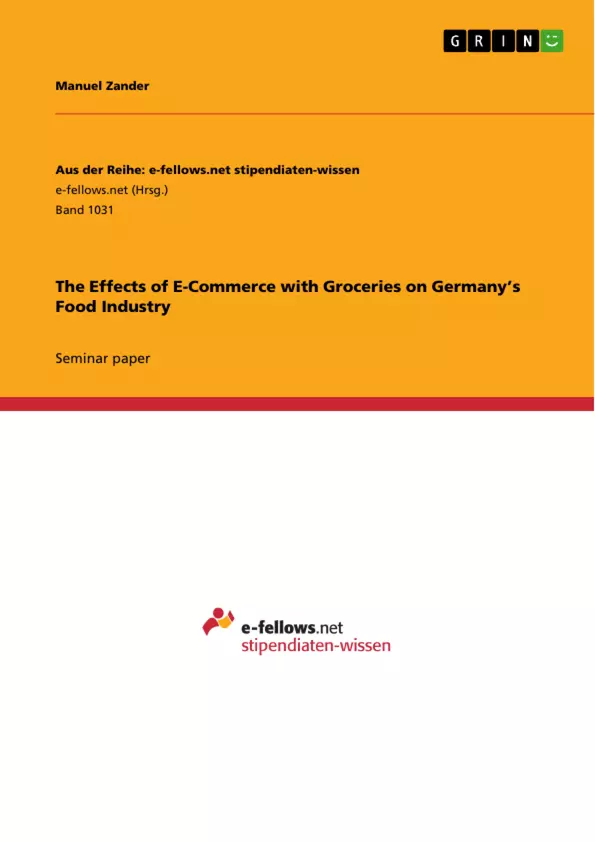This paper explains general aspects of E-Commerce with groceries and focuses on potential customers as well as on factors influencing the suppliers. Besides, it deals with recent characteristics of Germany’s food industry, hence concentrates on the actual demand and supply at both the retail sector and the online trading sector. Subsequently, possible effects of E-Commerce with groceries on the food market are described and summarized.
Diese Arbeit befasst sich mit den wichtigsten Aspekten von E-Commerce mit Lebensmitteln, mit potentiellen Zielgruppen, und mit verschiedenen Faktoren, die die Service-Anbieter beeinflussen. Des Weiteren wird die aktuelle Situation der deutschen Lebensmittelindustrie beschrieben - mit Bezug auf "traditionelle" Einzelhändler sowie Online-Händler. Schließlich werden mögliche Auswirkungen auf die Nahrungsmittelindustrie analysiert und zusammengefasst.
Inhaltsverzeichnis (Table of Contents)
- Introduction
- Basics of E-Commerce with groceries
- Potential customer groups and their benefits
- Success factors
- Problems
- Current situation in Germany
- German food retail industry
- E-Commerce with groceries: Status Quo
- Discussion: How online shopping of groceries could affect the food industry
- Conclusion
Zielsetzung und Themenschwerpunkte (Objectives and Key Themes)
This paper aims to explore the potential effects of E-Commerce with groceries on the German food industry. The paper analyzes the general aspects of E-Commerce with groceries, focusing on both the demand and supply sides. It then examines the current state of the German food retail industry, including the growth of online grocery shopping. The paper concludes by discussing the potential consequences of this growth on the traditional food industry.- The development and impact of E-Commerce with groceries
- Potential customer groups and their motivations for online grocery shopping
- Success factors for online grocery retailers
- The current state of the German food retail industry
- The potential effects of E-Commerce on the German food industry
Zusammenfassung der Kapitel (Chapter Summaries)
Introduction
This chapter introduces the topic of E-Commerce with groceries, highlighting its rapid growth and potential impact on the food industry. It focuses on the German market and outlines the paper's objective to investigate the potential effects of online grocery shopping on traditional food retailers.Basics of E-Commerce with groceries
This chapter delves into the fundamental aspects of E-Commerce with groceries, exploring different business models and identifying potential customer groups. It examines the benefits of online grocery shopping for different consumer groups, such as busy families, elderly individuals, and people with disabilities.Potential customer groups and their benefits
This chapter further explores the demographics and psychographics of online grocery shoppers, highlighting their motivations for choosing this shopping method. It examines the benefits of online grocery shopping for various customer groups, including time savings, convenience, and accessibility.Success factors
This chapter shifts focus to the supplier perspective, outlining key factors for successful online grocery businesses. It emphasizes the importance of building customer relationships, providing high-quality service, and ensuring operational efficiency.Current situation in Germany
This chapter examines the current state of the German food retail industry, analyzing the growth of online grocery shopping and its impact on traditional retailers. It assesses the market share of online grocery retailers and explores the challenges and opportunities presented by this evolving landscape.Discussion: How online shopping of groceries could affect the food industry
This chapter analyzes the potential effects of E-Commerce with groceries on the German food industry, considering both the positive and negative implications. It explores the potential impact on traditional retailers, consumer behavior, and market dynamics.Schlüsselwörter (Keywords)
E-Commerce, groceries, food industry, Germany, online shopping, customer groups, success factors, retail industry, market impact, consumer behavior.- Quote paper
- Manuel Zander (Author), 2013, The Effects of E-Commerce with Groceries on Germany’s Food Industry, Munich, GRIN Verlag, https://www.grin.com/document/283300



